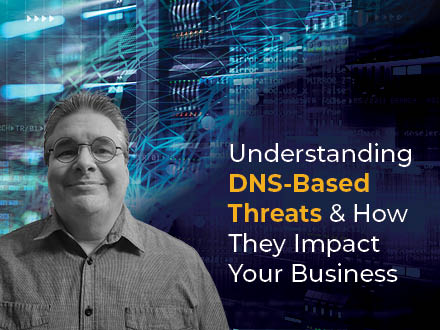Understanding DNS-Based Threats and How They Impact Your Business
By Thomas Coffey, VP of Security at CISO Global
Cybersecurity, DNS (Domain Name System), and your company are interconnected topics in the field of network security. Protecting a company’s cybersecurity, including its DNS infrastructure, is of utmost importance in today’s digital landscape. DNS is responsible for translating user-friendly domain names into machine-readable IP addresses, allowing devices to communicate with each other over the internet.
However, DNS is susceptible to various security concerns that can be exploited by cyber attackers. Here are a few important aspects related to cybersecurity and DNS:

DNS Attacks
Attackers can manipulate or exploit vulnerabilities in DNS to redirect legitimate traffic or launch various attacks. Some common DNS attacks include DNS cache poisoning, domain hijacking, DNS amplification, and distributed denial of service (DDoS) attacks targeting DNS infrastructure.
DNS Security Technologies
To enhance cybersecurity, various DNS security measures have been developed. This includes DNSSEC (Domain Name System Security Extensions) that adds digital signatures to DNS records, ensuring data integrity and authentication. DNS firewalls and DNS filters are also used to detect and block malicious DNS queries.
DNS Monitoring
Regular monitoring of DNS infrastructure is crucial for identifying and mitigating potential threats. Monitoring helps in detecting any unauthorized changes, unusual activities, or signs of compromise in the DNS system. Monitoring tools can generate alerts and log DNS-related activities for further analysis.
Phishing and DNS
Phishing attacks often rely on DNS to deceive users. Attackers may use phishing websites with similar domain names to trick users into entering sensitive information. Implementing anti-phishing techniques, like secure DNS configurations and SSL certificates, can help protect against such threats.
DNS Best Practices
To improve cybersecurity, it is advisable to follow DNS best practices. This includes keeping DNS software and systems up to date, using strong passwords for DNS accounts, implementing secure network configurations, and conducting regular DNS vulnerability assessments.
DNS Privacy
DNS requests can potentially expose user browsing habits and sensitive information. To address this, there are initiatives like DNS over HTTPS (DoH) and DNS over TLS (DoT) that encrypt DNS traffic, ensuring privacy and preventing eavesdropping.
Here are some key steps to consider for safeguarding your organization:
Implement Strong Access Controls
Ensure that only authorized personnel have access to critical systems, including DNS servers. Use strong passwords, enable multifactor authentication (MFA) where possible, and regularly review access rights to minimize the risk of unauthorized access.
Keep Systems Up to Date
Regularly patch and update all software, including the operating system and DNS software. This helps address known vulnerabilities and reduces the risk of exploitation by attackers.
Secure DNS Configurations
Configure DNS servers with security in mind. Restrict zone transfers, limit recursion to trusted sources, and disable unnecessary features and protocols to reduce the attack surface. Implement DNS Rate Limiting to mitigate the risk of DDoS attacks.
Use DNSSEC
Deploy DNSSEC, which adds digital signatures to DNS records, mitigating threats like DNS cache poisoning and ensuring data integrity and authenticity. DNSSEC helps prevent attackers from redirecting traffic to malicious websites.
Monitor DNS Traffic
Implement DNS monitoring solutions to detect anomalous activity, such as unusual DNS queries or unauthorized changes to DNS records. Monitoring can help identify potential DNS attacks or compromised systems.
Utilize DNS Firewalls and Filters
Deploy DNS firewalls or security platforms that inspect DNS traffic and block malicious queries or connections to known malicious domains. Filter DNS requests to prevent users from accessing suspicious or malicious websites.
Employee Education and Awareness
Train employees about cybersecurity best practices, the risks associated with phishing attacks, and how to identify and report suspicious emails or websites. Promote a culture of cybersecurity consciousness to reduce the likelihood of falling victim to attacks.
Regular Backups
Backup DNS zone files and configurations to facilitate recovery in case of a DNS compromise or failure. Regularly test and verify the integrity of backups to ensure they are reliable.
Engage with DNS Service Providers
If your organization relies on external DNS service providers, evaluate their security practices, including their DNS infrastructure’s resilience against attacks, DNSSEC deployment, and monitoring capabilities.
Stay Informed and Seek Expert Advice
Stay updated on the latest cybersecurity threats and trends. Engage with cybersecurity experts or consultants who can assess your organization’s security posture, recommend improvements, and help implement suitable security measures.
Remember, cybersecurity is an ongoing process, and a multi-layered approach is recommended to effectively protect your company’s sensitive data, systems, and DNS infrastructure from potential threats. Regular security audits, testing, and continuous improvement are essential for maintaining a strong security posture in the ever-evolving threat landscape. Overall, understanding the relationship between cybersecurity and DNS is crucial for establishing a secure online environment. Adequate measures should be taken to protect DNS infrastructure, monitor DNS activities, and stay updated with the latest security technologies and best practices.